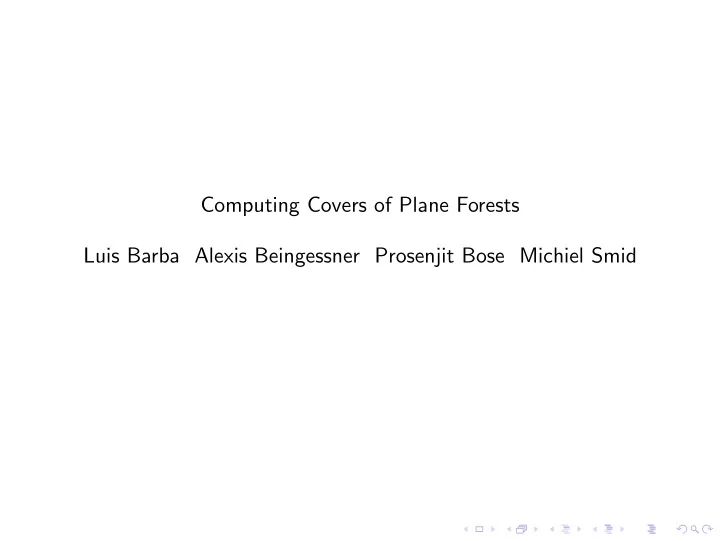

Computing Covers of Plane Forests Luis Barba Alexis Beingessner Prosenjit Bose Michiel Smid
Previous Work Given a set T = { T 1 , T 2 , . . . , T m } of m pairwise non-crossing geometric trees with a total of n vertices in general position. The coverage of these trees is the set of all points p in R 2 such that every line through p intersects at least one of the trees.
Previous Work
Previous Work
Previous Work Beingessner and Smid 2012: ◮ Coverage can be computed in O ( m 2 n 2 ) time ◮ Worst case example with coverage of size Ω( n 4 ). ◮ Problem is Θ( n 4 )
Previous Work Is slowness a consequence of bad inputs being “contrived”? Optimization to be had in structure of “real” inputs?
Observations Coverage of a single tree is it’s convex hull
Observations If two coverages overlap, their combined convex hull is covered
The hull-cover ◮ Compute the convex hull, CH ( T i ), of every tree T i ∈ T ◮ If any two convex hulls overlap, replace them with their convex hull ◮ Repeat until all convex hulls computed thusly are disjoint ◮ Resulting set of convex polygons is the hull-cover of T
The hull-cover
The hull-cover
The hull-cover
The hull-cover
The hull-cover
Approximation Does this approximate the coverage? ◮ A terrible approximation (for already hard inputs) ◮ A great approximation (for natural inputs)
Computing the hull-cover Challenges: ◮ Finding pairwise intersection is fairly expensive ◮ Computing convex hulls is fairly expensive
Weakly Disjoint Polygons Let a weakly disjoint pair of convex polygons P , Q be a pair of convex polygons such that P \ Q and Q \ P are both connected sets of points, and P does not share a vertex with Q .
Weakly Disjoint Polygons A pair of polygons that are weakly disjoint, but not disjoint
Weakly Disjoint Polygons A pair of polygons that are not weakly weakly disjoint
Weakly Disjoint Polygons Lemma If two convex polygons P , Q are weakly disjoint, then their boundaries intersect at at most two points.
Weakly Disjoint Polygons
Weakly Disjoint Polygons
Weakly Disjoint Polygons
Weakly Disjoint Polygons
Weakly Disjoint Polygons Lemma If two convex polygons P , Q are weakly disjoint, but not disjoint, then one contains a vertex of the other.
Weakly Disjoint Polygons
Lemma The convex hulls of two disjoint trees are weakly disjoint.
Weakly Disjoint Polygons
Blocked or Nested Lemma Assume R and S are two non-crossing trees whose convex hulls intersect. Then the convex hull of one is strictly inside the other, or there exists a pair of adjacent vertices on the convex hull of one whose visibility is blocked by the other tree.
Blocked or Nested
Shoot and Insert
Shoot and Insert Ishaque et al. 2012: n pairwise disjoint polygonal obstacles can be preprocessed in O ( n log n ) time and space to support m permanent ray shootings in O (( n + m ) log 2 n + m log m ) time
Algorithm
Algorithm
Algorithm
Algorithm 1
Algorithm 1 2
Algorithm 3 1 2
Algorithm 3 1 2 4
Algorithm 5 3 1 2 4
Algorithm 6 5 3 1 2 4
Algorithm 6 5 7 3 1 2 4
Algorithm 6 5 7 3 1 2 8 4
Algorithm 6 5 7 9 3 1 2 8 4
Algorithm
Algorithm
Analysis O ( n log 2 n ) time O ( n log n ) space
The End Thank you! Questions?
Recommend
More recommend